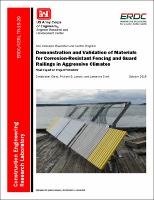Please use this identifier to cite or link to this item:
https://hdl.handle.net/11681/20203Full metadata record
| DC Field | Value | Language |
|---|---|---|
| dc.contributor | Mandaree Enterprise Corporation | - |
| dc.contributor | United States. Office of the Under Secretary of Defense for Acquisition, Technology, and Logistics | - |
| dc.contributor.author | Olaes, Christopher | - |
| dc.contributor.author | Lampo, R. (Richard) | - |
| dc.contributor.author | Clark, Lawrence | - |
| dc.date.accessioned | 2016-10-12T14:05:52Z | - |
| dc.date.available | 2016-10-12T14:05:52Z | - |
| dc.date.issued | 2015-10 | - |
| dc.identifier.uri | http://hdl.handle.net/11681/20203 | - |
| dc.description | Technical Report | - |
| dc.description | Abstract: Standard galvanized steel chain-link fencing, including products coated with polyvinyl chloride (PVC), can severely corrode in as little as 5 years in coastal locations where the atmosphere is warm, humid, and infused with chlorides. This problem affects fencing needed to secure military equipment, supplies, and buildings. Painted and galvanized-steel safety railings also can severely corrode in those environments, creating personal-safety hazards. This report describes a study that assessed several alternative corrosion-resistant materials for fencing and railings using atmospheric exposure coupons and full-scale installations. The research design compares the performance of the alternative and conventional materials to identify those that may reduce the Army’s corrosion prevention and control costs. Tested materials included fuse-bonded PVC, galvanized steel, stainless steel, aluminized steel, a proprietary material called Galfan®, aluminum alloys, and fiber-reinforced polymer (FRP) composites. The test exposure sites were Kahuku, HI; Duck, NC; and Treat Island, ME. The report provides cost justification for using specified corrosion-resistant fencing and railing materials that have a higher first cost than standard materials. The project return on investment using fuse-bonded fencing and anodized aluminum railings was calculated at 6.13; using fuse-bonded fencing and FRP composite railings instead of anodized aluminum railings, the calculated project ROI is 5.75. | - |
| dc.publisher | Construction Engineering Research Laboratory (U.S.) | - |
| dc.publisher | Engineer Research and Development Center (U.S.) | - |
| dc.relation | http://acwc.sdp.sirsi.net/client/en_US/search/asset/1046352 | - |
| dc.rights | Approved for public release; distribution is unlimited. | - |
| dc.source | This Digital Resource was created in Microsoft Word and Adobe Acrobat | - |
| dc.subject | Corrosion Prevention and Control Program (CPC) Alternative materials | - |
| dc.subject | Cost savings | - |
| dc.subject | Return on investment | - |
| dc.subject | Corrosive environments | - |
| dc.subject | Materials | - |
| dc.subject | Material evaluation | - |
| dc.subject | Fencing | - |
| dc.subject | Fences | - |
| dc.subject | Guard railings | - |
| dc.title | Demonstration and validation of materials for corrosion-resistant fencing and guard railings in aggressive climates : final report on Project F09-AR02 | - |
| dc.type | Report | en_US |
| Appears in Collections: | Technical Report | |
Files in This Item:
| File | Description | Size | Format | |
|---|---|---|---|---|
| ERDC-CERL-TR-15-29.pdf | 16.8 MB | Adobe PDF |  View/Open |